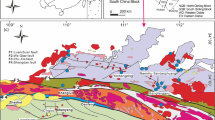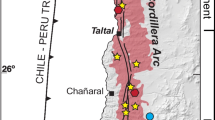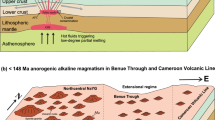Abstract
New zircon and apatite fission-track (FT) data, including apatite thermal modelling, are combined with an extensive literature survey and reconnaissance-type structural fieldwork in the Eastern Apuseni Mountains. This leads to a better understanding of the complex structural and thermal history of a key area at the boundary between two megatectonic units in the Balkan peninsula, namely the Tisza and Dacia Mega-Units. Following Late Jurassic obduction of the Transylvanian ophiolites onto a part of the Dacia Mega-Unit, that is, the Biharia nappe system, both units were buried to a minimum of 8 km during late Early Cretaceous times when these units were underthrust below the Tisza Mega-Unit consisting of the present-day Codru and Bihor nappe systems. Tisza formed the upper plate during Early Cretaceous (‘Austrian’) east-facing orogeny. Turonian to Campanian zircon FT cooling ages (95–71 Ma) from the Bihor and Codru nappe systems and the Biharia and Baia de Arieş nappes (at present the structurally lowest part of the Dacia Mega-Unit) record exhumation that immediately followed a second Cretaceous-age (i.e. Turonian) orogenic event. Thrusting during this overprinting event was NW-facing and led to the overall geometry of the present-day nappe stack in the Apuseni Mountains. Zircon FT ages, combined with thermal modelling of the apatite FT data, show relatively rapid post-tectonic cooling induced by a third shortening pulse during the latest Cretaceous (‘Laramian’ phase), followed by slower cooling across the 120°–60 °C temperature interval during latest Cretaceous to earliest Paleogene times (75–60 Ma). Cenozoic-age slow cooling (60–40 Ma) was probably related to erosional denudation postdating ‘Laramian’ large-scale updoming.















Similar content being viewed by others
References
Balc R, Suciu-Krausz E, Borbei F (2007) Biostratigraphy of the Cretaceous deposits in the Western Transylvanides from Ampoi Valley (Southern Apuseni Mountains, Romania). Studia Universitatis Babeş-Bolyai Geol 52:37–43
Balintoni I (1994) Structure of the Apuseni Mountains. In: ALCAPA II field guidebook “South Carpathians and Apuseni Mountains”. Romanian J Tectonics and Regional Geol 75:37–58
Balintoni I (1997) Geotectonica terenurilor metamorfice din Romania. Editura Carpatica, Cluj-Napoca; 176 pp
Balintoni I, Iancu V (1986) Lithostratigraphic and tectonic units in the Trascău Mountains, north of Mânăstirea Valley. DS Ins Geol Geofiz 70–71(5):45–56
Balintoni I, Balica C, Cliveţi M, Li L-Q, Hann HP, Chen Fukun, Schuller V (2009) The emplacement age of the Muntele Mare Variscan granite (Apuseni Mountains, Romania). Geol Carpathica 60:495–504
Balintoni I, Balica C, Ducea MN, Zaharia L, Chen Fukun, Cliveţi M, Hann HP, Li L-Q, Ghergari L (2010) Late Cambrian–Ordovician northeastern Gondwanan terranes in the basement of the Apuseni Mountains, Romania. J Geol Soc Lond 167:1131–1145
Balla Z (1987) Tertiary paleomagnetic data for the Carpatho-Pannonian region in the light of Miocene rotation kinematics. Tectonophysics 139:67–98
Berza T, Constantinescu E, Vlad SN (1998) Upper Cretaceous magmatic series and associated mineralization in the Carpathian-Balkan orogen. Resour Geol 48:291–306
Bleahu M, Dimian M (1967) Stratigraphic and tectonic studies in Feneş—Ighiel—Întregalde area (Metaliferi Mountains). Dări de Seamă ale Comitetului de Stat Geologic, LIII 1:281–304 (in Romanian)
Bleahu M, Lupu M, Patrulius D, Bordea S, Stefan A, Panin S (1981) The Structure of the Apuseni Mountains. Guide to Excursion B3. 12th Carpatho-Balkan Geological Association Congress, Bucharest, Romania. Institute of Geology and Geophysics, Bucharest, Guidebook 23, pp 107
Bleahu M, Soroiu M, Cǎtilina R (1984) On the Cretaceous tectonic-magmatic evolution of the Apuseni Mountains as revealed by K-Ar dating. Rev Roum Phys 29:123–130
Bortolotti V, Nicolae I, Marroni M, Pandolfi L, Principi G, Saccani E (2002) Geological and petrological evidences for Jurassic association of ophiolite and Island arc volcanics in the South Apuseni Mountains (Romanian Carpathians). Int Geol Rev 44:938–955
Brandon MT (1992) Decomposition of fission-track grain-age distributions. Am J Sci 292:535–564
Brandon MT, Roden-Tice MK, Garver JI (1998) Late Cenozoic exhumation of the Cascadia accretionary wedge in the Olympic Mountains, northwest Washington State. Geol Soc Am Bull 110:985–1009
Bucur I, Săsăran E (2005) Micropaleontological assemblages from the upper Jurassic—lower Cretaceous deposits of Trascău Mountains and their biostratigraphic significance. Acta Paleontologica Romaniae 5:27–38
Burchfiel BC (1980) Eastern European Alpine system and the Carpathian orocline as an example of collision tectonics. Tectonophysics 63:31–61
Carlson DW, Donelick RA, Ketcham RA (1999) Variability of apatite fission-track annealing kinetics, I. Experimental results. Am Min 84:1213–1223
Ciulavu D, Dinu C, Szakacs A, Dordea D (2000) Neogene kinematics of the Transylvanian basin (Romania). AAPG Bul 84:1589–1615
Cloetingh S, Bada G, Matenco L, Lankreijer A, Horváth F, Dinu C (2006) Modes of basin (de)formation, lithospheric strength and vertical motions in the Pannonian-Carpathian system: inferences from thermo-mechanical modelling. In: Gee DG, Stephenson RA (eds) European lithosphere dynamics. Geol Soc London Memoirs 32:207–221
Corrigan JD (1993) Apatite fission-track analysis of Oligocene strata in South Texas, USA: testing annealing models. Chem Geol 104:227–249
Csontos L, Vörös A (2004) Mesozoic plate tectonic reconstruction of the Carpathian region. Paleogeogr Paleoclimatol Paleoecol 210:1–56
Dallmeyer RD, Pană DI, Neubauer F, Erdmer P (1999) Tectonothermal evolution of the Apuseni Mountains, Romania: resolution of Variscan versus Alpine events with 40Ar/39Ar ages. J Geol 107:329–352
de Broucker G, Mellin A, Duindam P (1998) Tectono-stratigraphic evolution of the Transylvanian Basin pre-salt sequence Romania. In: Dinu C, Mocanu VH (eds) geological structure and hydrocarbon potential of the Romanian area, Bucharest Geoscience Forum 1:36–69
Dimitrescu R (1985) Early Caledonian event in the pre-Alpine metamorphic assemblages of the Romanian Carpathian. Acta Mineral Petrogr Szeged 27:59–70
Dumitru TA (1995) A new computer automated microscope stage system for fission track analysis. Nucl Tracks Radiat Meas 21:575–580
Ellero A, Leoni L, Marroni M, Nicolae I, Pandolfi L, Sartori F (2002) Deformation and metamorphism in the Feneş Nappe (southern Apuseni Mountains, Romania). C. R Geoscience 334:347–354
Filipescu S (2001) Cenozoic lithostratigraphic units in Transylvania. In: Bucur I, Filipescu S, Săsăran E, Field Trip Guide, 4th Regional Meeting IFAA 75–92
Fodor L, Csontos L, Bada G, Györfi I, Benkovics L (1999) Tertiary tectonic evolution of the Pannonian Basin system and neighbouring orogens: a new synthesis of palaeostress data. In: Durand B, Jolivet L, Horváth F, Séranne M (eds) The Mediterranean Basins: Tertiary extension within the Alpine Orogen. Geol Soc London Special Publ 156:295–334
Fügenschuh B, Schmid SM (2005) Age and significance of core complex formation in a very curved orogen: evidence from fission track studies in the South Carpathians (Romania). Tectonophysics 404:33–53
Galbraith RF, Green PF (1990) Estimating the component ages in a finite mixture. Nucl Tracks Radiat Meas 17:197–206
Galbraith RF, Laslett GM (1993) Statistical models for mixed fission-track ages. Nucl Tracks Radiat Meas 21:459–470
Gallagher K, Sambridge M (1994) Genetic algorithms: a powerful tool for large-scale nonlinear optimization problems. Comput Geosci 20:1229–1236
Garver JI, Soloviev AV, Bullen ME, Brandon MT (2000) Towards a more complete record of magmatism and exhumation in continental arcs using detrital fission track thermochronometry. Phys Chem Earth Part A 25:565–570
Gleadow AJW, Duddy IR (1981) A natural long-term annealing experiment for apatite. Nucl Tracks 5:169–174
Gleadow AJW, Duddy IR, Green PF, Lovering JF (1986) Confined fission track lengths in apatite: a diagnostic tool for thermal history analysis. Contrib Mineral Petrol 94:405–415
Green PF, Duddy IR (1989) Some comments on paleotemperature estimation from apatite fission track analysis. J Petrol Geol 12:111–114
Gröger HR, Fügenschuh B, Tischler M, Schmid SM, Foeken JPT (2008) Tertiary cooling and exhumation history in the Maramures area (internal eastern Carpathians, northern Romania): thermochronology and structural data. Geol Soc Lond Spec Publ 298:169–195
Györfi I, Csontos L, Nagymarosy A (1999) Early Tertiary structural evolution of the border zone between the Pannonian and Transylvanian Basins. In: Durand B, Jolivet L, Horváth F, Séranne M (eds) The Mediterranean basins: tertiary extension within the Alpine Orogen. Geol Soc London Special Publ 156:251–267
Haas J, Pero S (2004) Mesozoic evolution of the Tisza Mega-unit. Int J Earth Sci 93:297–313
Heinrich CA, Neubauer F (2002) Cu-Au-Pb-Zn-Ag metallogeny of the Alpine-Balkan Carpathian-Dinaride geodynamic province. Mineral Dep 37:533–540
Hoeck V, Ionescu C, Balintoni I, Koller F (2009) The Eastern Carpathians “ophiolites” (Romania): remnants of a Triassic ocean. Lithos 108:151–171
Horvath F, Bada G, Szafian P, Tari G, Adam A, Cloetingh S (2006) Modes of basin (de)formation, lithospheric strength and vertical motions in the Pannonian-Carpathian system: inferences from thermomechanical modeling. In: Gee DG, Stephenson RA (eds) European lithosphere dynamics. Geol Soc London Memoirs 32:191–206
Huismans RS, Bertotti D, Ciulavu D, Sanders CAE, Cloetingh S, Dinu C (1997) Structural evolution of the Transylvanian Basin (Romania): a sedimentary basin in the bend of the Carpathians. Tectonophysics 272:249–268
Hurford AJ, Green PF (1983) The zeta age calibration of fission-track dating. Chem Geol 41:285–317
Ilie M (1932) Harta geologica a muntilor Trascaului (Carte géologique des Monts Trascaului) 1: 55 000. Institutul geologic al Rômâniei Bucuresti. In: Anuarul institutului geologi al României 17
Ketcham R, Donelick R, Donelick M (2000) AFTSolve: a program for multi-kinetic modeling of apatite fission-track data. Geol Materials Res 1:1–32
Ketcham R, Carter A, Donelick RA, Barbarand J, Hurford AJ (2007) Improved modeling of fission-track annealing in apatite. Am Mineral 92:799–810
Kounov A, Seward D, Burg J-P, Bernoulli D, Ivanov Z, Handler R (2010) Geochronological and structural constraints on the Cretaceous thermotectonic evolution of the Kraishte zone (Western Bulgaria). Tectonics 29:TC2002. doi:10.1029/2009TC002509
Kräutner HG (1993) Pre-Alpine evolution in the southern Carpathians and adjacent areas. Geol Carpathica 44:203–212
Krézsek C, Bally A (2006) The Transylvanian Basin (Romania) and its relation to the Carpathian fold and thrust belt: insights in gravitational salt tectonics. Mar Petrol Geol 23:405–442
Laslett GM, Green PF, Duddy IR, Gleadow AJW (1987) Thermal annealing of fission track in apatite, 2. A quantitative analysis. Chem Geol 65:1–13
Ianovici V, Borcos M, Bleahu M, Patrulius D, Lupu, M, Dimitrescu R, Savu H (1976) Geologia Muntilor Apuseni. ed. Acad. RSR, Bucuresti, pp 631
Lupu M (1983) The Mesozoic history of the South Apuseni Mountains. Anuarul Institutului de Geologie şi Geofizică 60:115–124
Lupu M, Borcos M, Dimian M, Lupu D, Dimitrescu R (1967) Geological Map of Romania, scale 1:200 000, sheet Turda. Com Stat Geol, Bucuresti
Lupu M, Antonescu E, Avram E, Dumitrica P, Nicolae I (1995) Comments on the age of some ophiolites from the north Drocea Mts. Rom J Tectonics Reg Geol 76:21–25
Marton E, Tischler M, Csontos L, Fügenschuh B, Schmid SM (2007) The contact zone between the ALCAPA and Tisza-Dacia mega-tectonic units of Northern Romania in the light of new paleomagnetic data. Swiss J Geosci 100:109–124
Matenco L, Krézsek C, Merten S, Schmid S, Cloetingh S, Andriessen P (2010) Characteristics of collisional orogens with low topographic build-up: an example from the Carpathians. Terra Nova 22:155–165
McDougall I, Harrison TM (1999) Geochronology and Thermochronology by the 40Ar/39Ar Method, 2nd edn. Oxford University Press, New York, p 269
Merten S, Matenco L, Foeken JPT, Andriessen PAM (2011) Towards understanding the post-collisional evolution of an orogen influenced by convergence at adjacent plate margins: Late Cretaceous—Tertiary thermo-tectonic history of the Apuseni Mountains. Tectonics 30: TC6008. doi:10.1029/2011TC002887
Nicolae I, Saccani E (2003) Petrology and geochemistry of the Late Jurassic calc-alkaline series associated to Middle Jurassic ophiolites in the South Apuseni Mountains (Romania). Schweiz Mineral Petrogr Mitt 83:81–96
Nicolae I, Soroiu M, Bonhomme GM (1992) Ages K-Ar de quelques ophiolites des Monts Apuseni du Sud et leur signification géologique (Roumanie). Géologie Alpine 68:77–88
Pană D (1998) Petrogenesis and tectonics of the basement rocks of the Apuseni Mountains: significance for the Alpine tectonics of the Carpathian-Pannonian region. PhD thesis, University of Alberta
Pană D, Erdmer P (1994) Alpine crustal shear zones and pre-Alpine basement terranes in the Romanian Carpathians and Apuseni Mountains. Geology 22:807–810
Pană D, Heaman L, Creaser R, Erdmer P (2002) Pre-alpine crust in the apuseni mountains, romania: insights from Sm–Nd and U–Pb data. J Geol 110:341–354
Panaiotu C (1998) Paleomagnetic constraints on the geodynamic history of Romania. In: Ioane D (ed) Monograph of Southern Carpathians. Reports on Geodesy 7:205–216
Panaiotu C (1999) Paleomagnetic studies in Romania. Tectonophysics implications. PhD thesis. University of Bucharest (in Romanian), pp 265
Patrascu S (1993) Paleomagnetic study of some Neogene magmatic rocks from the Oas—Ignis—Varatec—Tibles Mountains (Romania). Geophys J Int 113:215–224
Patrascu S, Bleahu M, Panaiotu C (1990) Tectonic implications of paleomagnetic research into Upper Cretaceous magmatic rocks in the Apuseni Mountains, Romania. Tectonophysics 180:309–322
Pavelescu L, Pop G, Ailenei G, Ene I, Soroiu M, Popescu G (1975) K-Ar age determinations from the Apuseni and Banat Mountains. Rev Roum Geophys 19:67–69
Pécskay Z, Edelstein O, Seghedi I, Szakács A, Kovacs M, Crihan M, Bernad A (1995) K-Ar datings of the Neogene–Quaternary calc-alkaline volcanic rocks in Romania. Acta Vulcanol 7:53–63
Proust JN, Hosu A (1996) Sequence stratigraphy and Paleogene tectonic evolution of the Transylvanian Basin (Romania, eastern Europe). Sed Geol 105:117–140
Rădulescu DP, Săndulescu M (1973) The plate tectonics concept and the geological structure of the Carpathians. Tectonophysics 16:155–161
Roşu E, Pécskay Z, Stefan A, Popescu G, Panaiotu C, Panaiotu CE (1997) The evolution of the Neogene Volcanism in the Apuseni Mountains (Romania): constraints from new K-Ar data. Geol Carpathica 48:353–359
Roşu E, Panaiotu C, Pécskay Z, Panaiotu CE, Ivășcanu PM (2000) Neogene magmatism in the Apuseni Mountains, Romania. Evolution and geochemical features. An Inst Geol Rom 72:71–72
Roşu E, Seghedi I, Downes H, Alderton D, Szakacs A, Pecskay Z, Panaiotu C, Nedelcu L (2004) Extension-related Miocene calcalkaline magmatism in the Apuseni Mountains, Romania: origin of magmas. Schweiz Min Petrograph Mitt 84:153–172
Saccani E, Nicolae I, Tassinari R (2001) Tectonomagmatic setting of the Jurassic ophiolites from the South Apuseni Mountains (Romania): petrological and geochemical evidence. Ofioliti 26:9–22
Săndulescu M (1984) Geotectonica României. Tehnică, Bucharest, p 450
Săndulescu M (1994) Overview on Romanian geology. 2. Alcapa congress field guidebook. Rom J Tectonics Reg Geol 75(2):3–15
Săndulescu M, Kräutner HG, Balintoni I, Russo-Săndulescu D, Micu M (1981) The structure of the East Carpathians. Guide Book to Excursion B1 of the Carpatho-Balkan Geological Association 12th Congress, Bucharest pp 1–92
Săsăran E (2005) Calcarele Jurasicului superior—Cretacicului inferior din Muntii Trascău. Unpublished PhD thesis, University Cluj-Napoca
Schmid SM, Benoulli D, Fügenschuh B, Matenco L, Schefer S, Schuster R, Tischler M, Ustaszewski K (2008) The Alpine-Carpathian-Dinaridic orogenic system: correlation and evolution of tectonic units. Swiss J Geosci 101:139–183
Schuller V (2004) Evolution and geodynamic significance of the Upper Cretaceous Gosau basin in the Apuseni Mountains (Romania). Tübinger Geowissenschaftliche Arbeiten Reihe A 70, pp 112
Schuller V, Frisch W (2006) Heavy mineral provenance and paleocurrent data of the Upper Cretaceous Gosau succession of the Apuseni Mountains (Romania). Geol Carpathica 57:29–39
Schuller V, Frisch W, Danisik M, Dunkl I, Melinte MC (2009) Upper Cretaceous Gosau deposits of the Apuseni Mountains (Romania)—similarities and differences to the Eastern Alps. Aus J Earth Sci 102:133–145
Soroiu M, Popescu G, Kapser U, Dimitrescu R (1969) Contributions preliminaires a la geologie des massifs cristallins des Monts Apuseni. Ann Stiintifice Univ Iasi Sect IIb (Geol) 15:25–33
Stewart RJ, Brandon MT (2004) Detrital zircon fission-track ages for the “Hoh Formation”: implications for late Cenozoic evolution of the Cascadia subduction wedge. Geol Soc Am Bul 116:60–75
Tagami T (2005) Zircon Fission-Track Thermochronology and applications to Fault Studies. Rev Mineral Geochem 58:95–122
Tagami T, Dumitru TA (1996) Provenance and history of the Franciscan accretionary complex: constraints from zircon fission track thermochronology. J Geophys Res 101:8345–8355
Tagami T, Galbraith RF, Yamada R, Laslett GM (1998) Revised annealing kinetics of fission tracks in zircon and geological implications. In: Van den Haute P, de Corte F (eds) Advances in fission-track geochronology. Kluwer, Dordrecht, pp 99–114
Tischler M, Gröger HR, Fügenschuh B, Schmid SM (2007) Miocene tectonics of the Maramures area (Northern Romania): implications for the Mid-Hungarian fault zone. Int J Earth Sci (Geol. Rundschau) 96:473–496
Ustaszewski K, Schmid SM, Fügenschuh B, Tischler M, Kissling E, Spakman W (2008) A map-view restoration of the Alpine-Carpathian-Dinaridic system for the Early Miocene. Swiss J Geosci 101:273–294
Villa IM, Hermann J, Müntener O, Trommsdorff V (2000) 39Ar − 40Ar dating of multiply zoned amphibole generations (Malenco, Italian Alps). Contrib Mineral Petrol 140:363–381
von Cotta B (1864) Erzlagerstatten im Banat und in Serbien. W. Braumuller, Wien, p 108
von Quadt A, Moritz R, Peytcheva I, Heinrich CA (2005) 3: geochronology and geodynamics of Late Cretaceous magmatism and Cu–Au mineralization in the Panagyurishte region of the Apuseni-Banat-Timok-Srednogorie belt, Bulgaria. Ore Geol Rev 27:95–126
Willingshofer E, Neubauer F, Cloetingh S (1999) The significance of Gosau-type basins for the Late Cretaceous tectonic history of the Alpine-Carpathian Belt. Phys Chem Earth 24:687–695
Yamada R, Tagami T, Nishimura S, Ito H (1995) Annealing kinetics of fission tracks in zircon: an experimental study. Chem Geol 122:249–258
Zimmerman A, Stein HJ, Hannah JL, Koželj D, Bogdanov K, Berza T (2008) Tectonic configuration of the Apuseni-Banat-Timok-Srednogorie belt, Balkans-South Carpathians, constrained by high precision Re–Os molybdenite ages. Mineral Deposita 43:1–21
Acknowledgments
This study was funded by the Geological Institute of the Basel University and the Swiss National Science Foundation (projects ‘Tisza’ Nrs. 200021-101883/1 and 200020- 109278/1). The authors would like to thank Ioan Balintoni, Ioan Bucur and Emanoil Săsăran from the Babeş-Bolyai University (Cluj-Napoca), Mircea Săndulescu (Bucharest), as well as Volker Schuller (Tübingen) for introducing us to the Apuseni geology. We shared many discussions with all of them, as well as with Bernhard Fügenschuh, Martin Reiser (Innsbruck) and Liviu Matenco (Amsterdam). Daniel Bernoulli is thanked for his help that greatly improved the manuscript. Also, the constructive reviews of Volker Schuller and Franz Neubauer are gratefully acknowledged.
Author information
Authors and Affiliations
Corresponding author
Rights and permissions
About this article
Cite this article
Kounov, A., Schmid, S.M. Fission-track constraints on the thermal and tectonic evolution of the Apuseni Mountains (Romania). Int J Earth Sci (Geol Rundsch) 102, 207–233 (2013). https://doi.org/10.1007/s00531-012-0800-5
Received:
Accepted:
Published:
Issue Date:
DOI: https://doi.org/10.1007/s00531-012-0800-5




